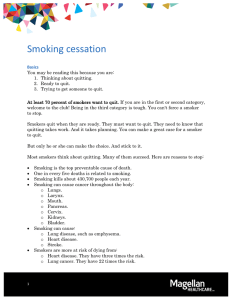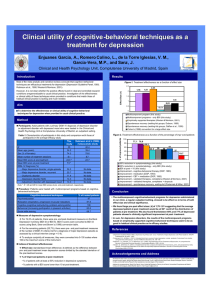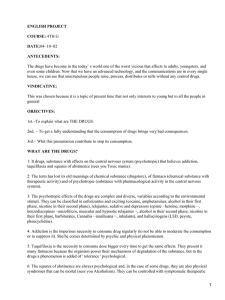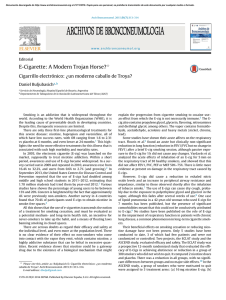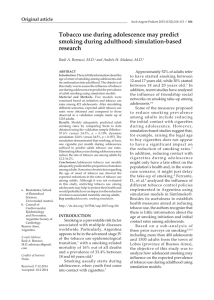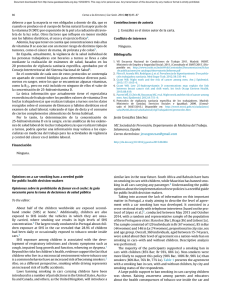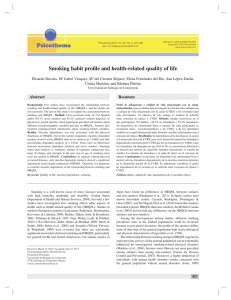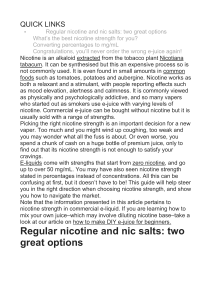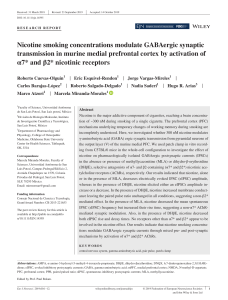Asociación entre el hábito de fumar y la sintomatología depresiva
Anuncio
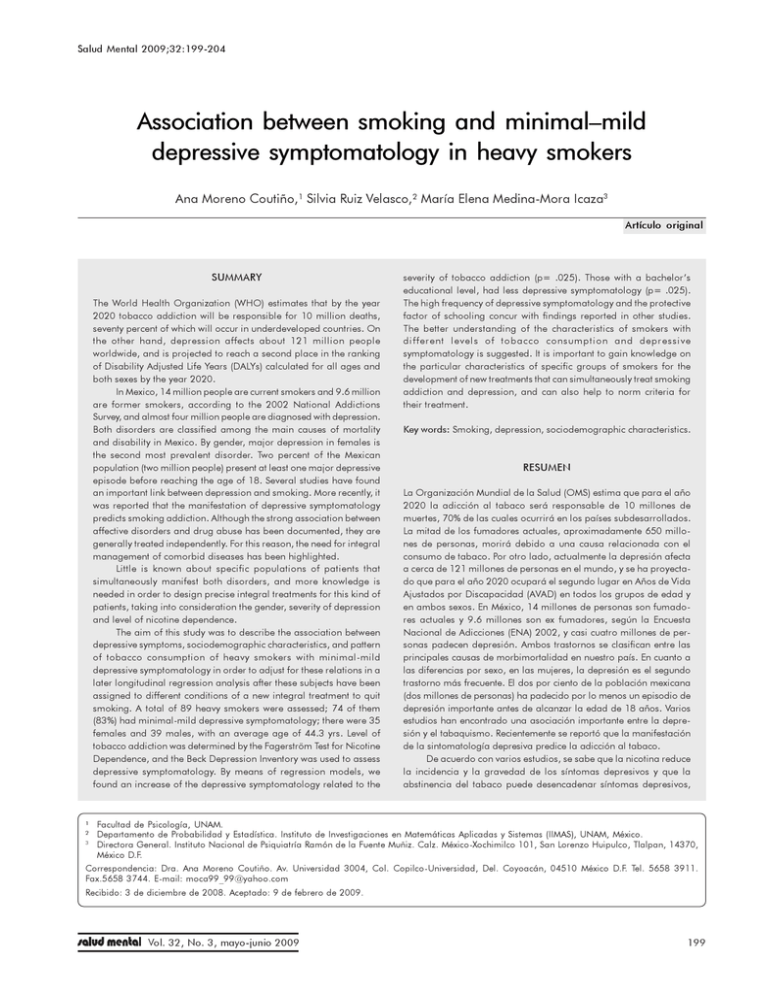
Salud Mental 2009;32:199-204Smoking and minimal–mild depressive symptomatology in heavy smokers Association between smoking and minimal–mild depressive symptomatology in heavy smokers Ana Moreno Coutiño,¹ Silvia Ruiz Velasco,² María Elena Medina-Mora Icaza3 Artículo original SUMMARY The World Health Organization (WHO) estimates that by the year 2020 tobacco addiction will be responsible for 10 million deaths, seventy percent of which will occur in underdeveloped countries. On the other hand, depression affects about 121 million people worldwide, and is projected to reach a second place in the ranking of Disability Adjusted Life Years (DALYs) calculated for all ages and both sexes by the year 2020. In Mexico, 14 million people are current smokers and 9.6 million are former smokers, according to the 2002 National Addictions Survey, and almost four million people are diagnosed with depression. Both disorders are classified among the main causes of mortality and disability in Mexico. By gender, major depression in females is the second most prevalent disorder. Two percent of the Mexican population (two million people) present at least one major depressive episode before reaching the age of 18. Several studies have found an important link between depression and smoking. More recently, it was reported that the manifestation of depressive symptomatology predicts smoking addiction. Although the strong association between affective disorders and drug abuse has been documented, they are generally treated independently. For this reason, the need for integral management of comorbid diseases has been highlighted. Little is known about specific populations of patients that simultaneously manifest both disorders, and more knowledge is needed in order to design precise integral treatments for this kind of patients, taking into consideration the gender, severity of depression and level of nicotine dependence. The aim of this study was to describe the association between depressive symptoms, sociodemographic characteristics, and pattern of tobacco consumption of heavy smokers with minimal-mild depressive symptomatology in order to adjust for these relations in a later longitudinal regression analysis after these subjects have been assigned to different conditions of a new integral treatment to quit smoking. A total of 89 heavy smokers were assessed; 74 of them (83%) had minimal-mild depressive symptomatology; there were 35 females and 39 males, with an average age of 44.3 yrs. Level of tobacco addiction was determined by the Fagerström Test for Nicotine Dependence, and the Beck Depression Inventory was used to assess depressive symptomatology. By means of regression models, we found an increase of the depressive symptomatology related to the severity of tobacco addiction (p= .025). Those with a bachelor’s educational level, had less depressive symptomatology (p= .025). The high frequency of depressive symptomatology and the protective factor of schooling concur with findings reported in other studies. The better understanding of the characteristics of smokers with different levels of tobacco consumption and depressive symptomatology is suggested. It is important to gain knowledge on the particular characteristics of specific groups of smokers for the development of new treatments that can simultaneously treat smoking addiction and depression, and can also help to norm criteria for their treatment. Key words: Smoking, depression, sociodemographic characteristics. RESUMEN La Organización Mundial de la Salud (OMS) estima que para el año 2020 la adicción al tabaco será responsable de 10 millones de muertes, 70% de las cuales ocurrirá en los países subdesarrollados. La mitad de los fumadores actuales, aproximadamente 650 millones de personas, morirá debido a una causa relacionada con el consumo de tabaco. Por otro lado, actualmente la depresión afecta a cerca de 121 millones de personas en el mundo, y se ha proyectado que para el año 2020 ocupará el segundo lugar en Años de Vida Ajustados por Discapacidad (AVAD) en todos los grupos de edad y en ambos sexos. En México, 14 millones de personas son fumadores actuales y 9.6 millones son ex fumadores, según la Encuesta Nacional de Adicciones (ENA) 2002, y casi cuatro millones de personas padecen depresión. Ambos trastornos se clasifican entre las principales causas de morbimortalidad en nuestro país. En cuanto a las diferencias por sexo, en las mujeres, la depresión es el segundo trastorno más frecuente. El dos por ciento de la población mexicana (dos millones de personas) ha padecido por lo menos un episodio de depresión importante antes de alcanzar la edad de 18 años. Varios estudios han encontrado una asociación importante entre la depresión y el tabaquismo. Recientemente se reportó que la manifestación de la sintomatología depresiva predice la adicción al tabaco. De acuerdo con varios estudios, se sabe que la nicotina reduce la incidencia y la gravedad de los síntomas depresivos y que la abstinencia del tabaco puede desencadenar síntomas depresivos, ¹ Facultad de Psicología, UNAM. ² Departamento de Probabilidad y Estadística. Instituto de Investigaciones en Matemáticas Aplicadas y Sistemas (IIMAS), UNAM, México. 3 Directora General. Instituto Nacional de Psiquiatría Ramón de la Fuente Muñiz. Calz. México-Xochimilco 101, San Lorenzo Huipulco, Tlalpan, 14370, México D.F. Correspondencia: Dra. Ana Moreno Coutiño. Av. Universidad 3004, Col. Copilco-Universidad, Del. Coyoacán, 04510 México D.F. Tel. 5658 3911. Fax.5658 3744. E-mail: [email protected] Recibido: 3 de diciembre de 2008. Aceptado: 9 de febrero de 2009. Vol. 32, No. 3, mayo-junio 2009 199 Moreno Coutiño et al. por lo que se ha sugerido que las personas con depresión fuman a manera de automedicación contra la sintomatología depresiva. A pesar de que ha sido documentada la fuerte asociación entre los trastornos afectivos y las adicciones, estos trastornos se atienden generalmente de manera independiente. Por esta razón, se ha subrayado la necesidad de generar tratamientos integrales para los trastornos comórbidos. Hasta el momento, se sabe poco sobre poblaciones específicas de pacientes que de manera simultánea son adictos al tabaco y padecen sintomatología depresiva, por lo se requiere de mayor entendimiento de sus características para diseñar tratamientos integrales específicos para este tipo de pacientes. Para ello se debe tomar en consideración el sexo, la gravedad de la depresión y el nivel de dependencia de la nicotina. El objetivo del presente estudio fue describir la relación que existe entre los síntomas depresivos, las características sociodemográficas y el patrón de consumo de tabaco en fumadores fuertes con sintomatología depresiva mínima leve para ajustar dichas relaciones mediante un modelo de regresión longitudinal, en un estudio posterior, donde los pacientes serán asignados a diversas condiciones terapéuticas de un nuevo tratamiento integral contra el tabaquismo. Un total de 89 fumadores fuertes fueron evaluados; 74 de ellos (83%) padecían sintomatología depresiva mínima leve; había 35 INTRODUCTION Worldwide, tobacco addiction is one of the main causes of preventable morbi-mortality and low quality of life; and it is also responsible for five million deaths per year (one out of 10 adult deaths worldwide). Half of the current smokers, approximately 650 million people, will die due to a cause related to tobacco consumption. If these tendencies persist by the year 2020, the World Health Organization (WHO) estimates that tobacco addiction will be responsible for 10 million deaths, 70% of which will occur in underdeveloped countries. On the other hand, depression affects about 121 million people worldwide, and is projected to reach a second place in the ranking of Disability Adjusted Life Years (DALYs) calculated for all ages and both sexes by the year 2020. Today, depression is already the second cause of DALYs in the 15-44 age range for both sexes combined.1 In Mexico, 14 million people are current smokers and 9.6 million are former smokers, according to the National Addictions Survey,2 and almost four million people are diagnosed with depression. Both disorders are classified among the main causes of mortality and disability.3 By gender, major depression in females is the second most prevalent disorder. Two percent of the Mexican population (two million people) present at least one major depression episode before reaching the age of 18.4 The peaks of incidence for major depression are approximately at 17, 32 and 65 years.5 Several studies have found an important link between depression and smoking. 6-12 Smokers with a history of depression tend to relapse into depression when trying to quit.13 200 mujeres y 39 hombres, con una media de edad de 44.3 años. El nivel de adicción al tabaco fue determinado por la prueba de Fagerström para la dependencia a la nicotina, y se usó el Inventario de Depresión de Beck para determinar el nivel de sintomatología depresiva. Mediante un modelo de regresión, encontramos un aumento de la sintomatología depresiva relacionada con la gravedad de la dependencia al tabaco (p=.025). Aquellos con nivel de enseñanza de licenciatura presentaron menos sintomatología depresiva (p=.025). Los principales resultados de este estudio son la asociación significativa entre el nivel de dependencia al tabaco y la sintomatología depresiva en fumadores fuertes. Tanto la alta incidencia de la sintomatología depresiva como el factor protector de la enseñanza concuerdan con los reportes de otros estudios con fumadores. Es importante conocer las características particulares de grupos específicos de fumadores para desarrollar nuevos tratamientos que pueden tratar simultáneamente la adicción al tabaco y la depresión, así como para ayudar a normar criterios para su tratamiento. Se sugiere continuar ahondando en el conocimiento de las características de los fumadores con diversos niveles de consumo de tabaco y sintomatología depresiva. Palabras clave: Tabaquismo, depresión, características sociodemográficas. More recently, it was reported that the manifestation of depressive symptomatology predicts smoking addiction.14 To determine the probability of substance abuse co-occuring with affection disorders, a study found that the latter occurred before substance abuse or dependence in 47% of males and 26% of females.15 Some of the differences between genders have been addressed. Women smokers are two times more likely to present depression symptomatology compared to non-smoking women, and five times more likely than men, while men who smoke more than one pack a day are five times more likely to manifest depression symptoms compared to non-smoking men. Current and former smokers are more likely to present depression compared to those who have never smoked.12,16 Although the strong association between affective disorders and drug abuse has been documented, they are generally treated independently. For this reason, the need for integral management of comorbid diseases has been highlighted.15,17,18 Based on several studies, we know that nicotine reduces both the incidence and severity of depressive symptoms19-23 and that tobacco abstinence can uncover depressive symptoms. 23 More specifically, when these appear during the sixth week and sixth month of abstinence reincidence in smoking is expected.24 This correlates with results obtained among depressed patients undergoing treatment in which the acceptance of anti-tobacco therapy is better than in untreated patients.25 It has been proposed that people with depression smoke as a form of automedication against depressive Vol. 32, No. 3, mayo-junio 2009 Smoking and minimal–mild depressive symptomatology in heavy smokers symptomatology by using negative reinforcement.20,23,26 This explains why, in order to counteract nicotine abstinence symptoms, the administration of antidepressive drugs, such as bupropion and nortriptiline, has positive results.27-32 Little is known about specific populations of patients that simultaneously manifest both disorders, and more knowledge is needed in order to design precise integral treatments for this kind of patients, taking into consideration the gender, severity of depression and level of nicotine dependence. In Mexico, prevalence reports for mild and moderate depressive symptomatology are 23% and 49%, respectively.5 The aim of this study was to describe the association between depressive symptoms, sociodemographic characteristics, and pattern of tobacco consumption in order to adjust for these relations in a later longitudinal regression analysis after subjects have been assigned to one of three different conditions of a new integral treatment. METHODS Participants A total of 89 heavy smokers —which were Mexican members of the university community, either students, academics (researchers and lectureres), administrative (secretaries, accountants and functionaries) or support employees (watchmen and maintenance workers)— who attended after being invited for treatment of tobacco addiction at the Clinic Against Addictions of the National Autonomous University of Mexico (UNAM) were assessed. Heavy smoking was defined as consuming more than 10 cigarettes per day. Depressive symptomatology was found in 83 patients (93%). Minimal-mild symptoms were present in 74 patients (83%) and heavy depressive symptoms were found in nine patients (10%). For this study, 15 patients were excluded: those with heavy depressive symptoms, three cocaine addicts, two pregnant women and one patient with schizoid traits. The 74 heavy smokers with minimal-mild depressive symptoms included in this study were 35 females (47.3%) and 39 males (52.7%), with an age average of 44.3 years (SD 10.96). Procedure Psychologists trained in the rehabilitation of smokers approached smokers through individual and group invitations in diverse entities of the university and arranged, for those interested, an appointment for evaluation at the Clinic Against Addictions of the UNAM, between February and July 2007. The level of tobacco addiction was determined by the Fagerström Test for Nicotine Dependence (FTND).33 Besides Vol. 32, No. 3, mayo-junio 2009 this data, information regarding their general pattern of tobacco consumption was collected during the initial interview. The Beck Depression Inventory (BDI) of 21 items was used to assess depressive symptomatology.34 The latter has been validated for its application among Mexicans, and the Spanish versions of both the FTND and the BDI have been extensively used. 35-39 Carbon monoxide (CO) exhalation level and a sample of urine were requested to corroborate smoking level. To measure the alveolar concentration of CO in exhalation in ppm (parts per million) a Micro Medical, Micro CO detector, was used. A gas chromatographic-mass spectrometric method was used for the detection and quantification of cotinine in urine, taking in to account the deuterated internal standard, following the method of Hutchinson et al. 40 The analyses were extracted by liquid-liquid extraction coupled to centrifugation and evaporation. The cut-off point for cotinine to verify abstinence was 40ng/ml, since the equipment could not verify any lower than that. The calibration curve for cotinine was created from 1-10 000 ng/ml. All data were corrected by recovery efficiencies. The information collected was captured in a data base for analysis by means of regression models using the Stata 10 program, where the dependent variable was the score obtained in the Beck Depression Inventory and the independent variables were all the sociodemographic variables. We used a stepwise procedure to find out the independent variables that had a significant effect on the BDI, and included gender, age, and marital status. RESULTS Table 1 shows the sociodemographic characteristics of the 74 heavy smokers included in this study. It also describes the principal patterns of smoking and depressive symptomatology. In the whole population, the mean number of cigarettes consumed per day was 18 cigarettes (SD 7.6); the age of first tobacco use was 15.46 years (SD 4.33), that for years smoking was 25.39 (SD 10.09), and the level of nicotine dependence, according to the Fagerström test, was 4.73 points (SD 2.21), which corresponds to a moderate level of dependence. The median of the depressive symptomatology according to the Beck Inventory was 8.99 points (SD 5.77), which corresponds to a minimal level of depression. The p value for categorical variables was calculated with Pearson’s χ² statistic, and continuous variables were analyzed on a mean difference t-test. It is worth mentioning that both males (n=39) and females (n=35) included in the study were similar in age, school level, working status, age of first cigarette, years smoking, level of nicotine dependence, and depressive symptomatology. The only differences found were in the marital status and the pattern 201 Moreno Coutiño et al. Table 1. Characteristics of severe smokers by gender Table 2. Beck Depression Inventory and Sociodemographic Characteristics Mean Men (n= 39) Age (years) No. of cigarette per day Age of first cigarette (years) Years smoking Level of nicotine dependence (Fagerström) Level of depression (Beck) Cotinine CO Women (n= 35) 42.21 19.46 14.44 24.87 5.0 46.68 16.25 16.57 26.00 4.42 .079 .070 .033 .627 .271 8.51 4390.41 21.41 9.51 3023.70 20.77 .460 .101 .792 Frequency % Marital status Single Married Divorced Women 23.08 61.54 15.38 48.57 42.86 8.57 .069 School level < High school High school Bachelor’s degree Post-graduate degree Laboral activity Academia Administrative Support employee Student Men .865 12.82 15.38 51.28 20.51 17.14 20.0 42.86 20.0 22.86 48.57 22.86 5.71 of smoking behavior, with males reporting a significant higher number of cigarettes per day. Results of the regression models are shown in table 2. The results of statistically significant variables and the main sociodemographic characteristics, such as gender, age and marital status, are reported. Variables, such as reasons for smoking initiation, years consuming the current amount of cigarettes, number of attempts to quit smoking, living and working with other smokers, level of carbon monoxide in exhalation and cotinine urine level, did not reach significant values. Nicotine dependence level was considered as a continuous variable, and its effect represents a 0.68 increment in Beck’s scale for each change of one unit in the level of dependence in the Fagerström test, showing that nicotine dependence was a risk factor for depression. On the other hand, bachelor’s school level and administrative working status are protective factors against depressive symptomatology. DISCUSSION The main findings of this study are the significant association between the level of tobacco dependence and the increment of depressive symptomatology in heavy smokers, in 202 Confidence Interval P value 0.000 1.000 -1.687, 3.690 0.460 .046 -.169, 0.077 0.460 0.000 0.551 2.876 -2.371, 3.476 -1.587, 7.339 0.708 0.203 Support employee Administrative Student Academia 0.000 -2.807 -1.565 -1.165 -5.931, 0.315 -6.248, 3.153 -5.520, 3.190 0.077** 0.510 0.595 School level < High school High school Bachelor’s degree Post-graduate degree 0.000 0.140 -5.291 -3.091 -4.254, 4.534 -8.999, 1.583 -7.349, 1.167 0.950 0.006* 0.152 0.680 0.089, 1.271 0.025* Gender Women Men Age Marital status Single Married Divorced Laboral activity Level of nicotine dependence (Fagerström) .560 5.13 41.03 38.46 15.38 Coefficient p value *significance to 5%, ** significance to 10%. concordance with the results in studies performed with different groups of smokers,6-10,41 as well as the significant relation between the bachelor’s level of education and the decrease in the Beck Depression Inventory score. Patients with bachelor’s school level were more than five points under those with school level lower than high school. A tendency in the decrease of depressive symptomatology was also observed in patients with post-graduate degrees, which was probably non-significant due to the size of the sample. These findings are similar to previous reports that state that education level acts as a protective factor against tobacco addiction.42,43 In relation to working status, a marginal protector factor was found for those in the administrative area, compared to support employees. On average, the BDI scores of the first were almost three points below. This finding could be related to the connection between educational level and working status, since almost half of the support employees had lower than high school educational level. Although the level of tobacco dependence and the increment of depressive symptomatology associated significantly, this was not reflected in the variables of carbon monoxide and cotinine levels, maybe because the time for the collection of the samples after smoking was not controlled. In those variables where differences by gender were significant, such as marital status and number of cigarettes per day, models of regression were adjusted separately by gender and no significant differences were found. However, most patients that consumed more than one pack of cigarettes per day were men. This is consistent with review reports.2,41 Vol. 32, No. 3, mayo-junio 2009 Smoking and minimal–mild depressive symptomatology in heavy smokers These results highlight the need for simultaneous treatments for smoking cessation and depression, particularly for heavy smokers with low school level and minimal-mild depressive symptomatology. Recently, the treatment against tobacco addiction for smokers simultaneously diagnosed with a psychiatric disorder has been evaluated.18 In relation to the acceptance of smoking addiction treatment among patients with depression, it has been reported that those under medication are the ones that better accept treatment, and that neither the severity of the depressive symptoms, the previous history of depression, nor the recurrence of the disorder are associated with the acceptance of the treatment.25 The available treatments against tobacco addiction are psychological and pharmacological. The experience with isolated psychological treatment has shown low abstinence rates, and for this reason pharmacologic treatment is advised when possible.44 Since smokers with depression history have higher probabilities of experiencing depressive symptoms during abstinence, it is necessary to examine if post-abstinence treatment with antidepressants can prevent such symptomatology.30 The nicotine patch and the antidepressant bupropion are the most successful pharmacological treatments against tobacco addiction, and are also highly effective in the treatment of depression,19,21,22,28,31,44-51 and for this reason a simultaneous treatment using these pharmacological treatments should be considered for both disorders. Patients with mental disorders and simultaneous substance abuse disorder represent a challenge for health professionals since substance consumption limits the use of drugs for the psychiatric treatment.15 None the less, the pharmacological treatment can favor both disorders at the same time in patients with depression and tobacco addiction. After analyzing the results in our study and comparing them the international literature, we suggest the implementation of integral treatments that take into consideration both disorders, and implement both psychological and pharmacologic treatments. We also suggest that particular smoker’s characteristics, such as number of cigarettes per day, level of nicotine dependence, school level and the level of depression, should be taken into account for the development of more accurate treatments. ACKNOWLEDGMENTS The authors wish to thank Gabriela Moreno-Coutiño MD. for her collaboration in translating of this paper. REFERENCES 1. World Health Organization. Global burden of disease. Geneva 2007 [consult October 12th 2008] Available at: http://www.who.int/healthinfo/ global_burden_disease/en/index.html Vol. 32, No. 3, mayo-junio 2009 2. Secretaría de Salud, Instituto Nacional de Estadística, Geografía e Informática. Encuesta Nacional de Adicciones 2002. México, DF: Consejo Nacional de Adicciones; 2002. 3. Secretaría de Salud. Plan Nacional de Salud 2001-2006. México, DF: Secretaría de Salud; 2001. 4. Secretaría de Salud. Programa específico de depresión. México, DF: Servicios de Salud Mental; 2002. 5. Medina-Mora ME, Borges G, Lara C, Benjet C, Blanco J et al. Prevalence, service use, and demographic correlates of 12-month DSM-IV psychiatric disorders in Mexico: results from the Mexican National Comorbidity Survey. Psychol Med 2005;35:1773-1783. 6. Breslau N, Kilbey M, Andreski P. Nicotine withdrawal symptoms and psychiatric disorders: findings from an epidemiological study of young adults. Am J Psychiatry 1992;149:464- 469. 7. Breslau N, Kilbey M, Andreski P. Nicotine dependence and major depression: new evidence from a prospective investigation. Arch Gen Psychiatry 1993;50:31-35. 8. Breslau N, Novak SP, Kessler RC. Psychiatric disorders and stages of smoking. Biol Psychiatry 2004;55:69-76. 9. Glassman A, Helzer JE, Covey LS. Smoking, smoking cessation and major depression. JAMA 1990;264:1546-1594. 10. Stage KB, Glassman AH, Covey LS. Depression after smoking cessation: case reports. J Clin Psychiatry 1996;57:467-469. 11. Lyons M, Hitsman B, Xian H, Panizzon MS, Jerskey BA et al. A twin study of smoking, nicotine dependance, and major depression in men. Nicotine Tob Res 2008;10:97-108. 12. Wiesbeck GA, Kuhl HC, Yaldizili O, Wurst FM. Tobacco smoking and depresión- results from the WHO/ISBRA study, Neuropsychobiology 2008;57:26-31. 13. Glassman A, Covey LS, Stetner F, Rivelli S. Smoking cessation and the course of major depression: a follow-up study. Lancet 2001;357:1929-1932. 14. Munafò MR, Hitsman B, Rende R, Metcalfe C, Niaura R. Effects of progression to cigarette smoking on depressed mood in adolescents: evidence from the National Longitudinal Study of Adolescent Health. Addiction 2008;103:162-171. 15. Medina-Mora ME, Borges G, Lara C, Benjet C. La salud mental en México y los retos para su atención. Resultados de la Encuesta Nacional de Epidemiología Psiquiátrica. Manual de Trastornos Mentales. México: Asociación Psiquiátrica Mexicana AC; 2006. 16. Benjet C, Borges GG, Medina-Mora ME, Fleiz-Bautista C, ZambranoRuiz J. La depresión con inicio temprano: prevalencia, curso natural y latencia para buscar tratamiento. Salud Publica Mex 2004;46(5):17-24. 17. Foulds J, Steinberg MB, Williams JM, Ziedonis DM. Developments in pharmacotherapy for tobacco dependence: past, present and future. Drug Alcohol Rev 2008;25:59-71. 18. Saxon AJ, Baer JS, Davis TM, Sloan KL, Malte CA et al. Smoking cessation treatment among dually diagnosed individuals: preliminary evaluation of different pharcotherapies. Nicotine Tob Res 2003;5(4):589-596. 19. Lai I, Hong Ch, Tsai S. Association study of nicotinic-receptor variants and major depressive disorder. J Affect Disord 2001;66:79-82. 20. Pomerleau CS. Co-factors for smoking and evolutionary psychobiology. Addiction 1997;92(4):397-408. 21. Salín-Pascual R, de la Fuente JR, Galicia-Polo L, Drucker-Colín R. Effects of transdermal nicotine on mood and sleep in nonsmoking major depressed patients. Psychopharmacology 1995;121:476-479. 22. Salín-Pascual R, Drucker-Colín R. A novel effect of nicotine on mood and sleep in major depression. Neuroreport 1998;9:57-60. 23. Moreno-Coutiño A, Calderón-Ezquerro C, Drucker-Colín R. Long term changes in sleep and depressive symptoms of smokers in abstinente. Nicotine Tob Res 2007;9:389-396. 24. Catley D, Harris KJ, Okuyemi KS, Mayo MS, Pankey E et al. The influence of depressive symptoms on smoking cessation among African Americans in a randomized trial of bupropion. Nicotine Tob Res 2005;7:859-870. 203 Moreno Coutiño et al. 25. Haug NA, Hall SM, Prochaska JJ. Acceptance of nicotine dependence treatment among currently depressed smokers. Nicotine Tob Res 2005;7:217-224. 26. Mihailescu S, Drucker-Colín R. Nicotine, brain nicotinic receptors, and neuropsychiatric disorders. Arch Med Res 2000;31:131-144. 27. Aveyard P, Johnson C, Fillingham S, Parsons A, Murphy M. Nortriptyline plus nicotine replacement versus placebo plus nicotine replacement for smoking cessation: pragmatic randomized controlled trial. Br Med J 2008;336:1223-1227. 28. Glover ED, Glover PN. Pharmacologic treatments for the nicotine dependent smoker. Am J Health Behav 2001;25(3):179-182. 29. Hitsman B, Pingitore R, Spring B, Mahableshwarkar A, Mizes JS et al. Antidepressant pharmacotherapy helps some cigarette smokers more than others. J Consult Clin Psychol 1999;67:547-554. 30. Hughes JR. Depression during tobacco abstinence. Nicotine Tob Res 2007;9:443-446. 31. Hurt RD, Sachs DP, Glover ED, Offord KP, Johnston JA, et al. A comparison of sustained-release bupropion and placebo for smoking cessation. N Engl J Med 1997;337:1195-1202. 32. Lerman C, Niaura R, Collins BN. Effect of bupropion on depression symptoms in a smoking cessation clinical trial. Psychol Addict Behav 2004;18:362-366. 33. Heatherton T, Kozlowski L, Frecker R, Fagerström K. The Fagerström Test for Nicotine Dependence: a revision of the Fagerström Tolerance Questionnarie. Br J Adict 1991;86:1119-1127. 34. Jurado S, Villegas ME, Méndez L, Rodríguez F, Loperena V et al. La estandarización del Inventario de Depresión de Beck para los residentes de la Ciudad de México. Salud Mental 1998;21:26-31. 35. Beck, CT, Froman RD, Bernal H. Acculturation level and postpartum depression in Hispanic mothers. Am J Matern Child Nurs 2005;30:299-204. 36. Becoña E, Vázquez FL. The Fargestrom Test for Nicotine Dependence in a Spanish sample. Psychol Rep 1998;83:1455-1458. 37. Esquivel-Molina CG, Buendía-Cano F, Martínez-García O, MartínezMendoza JA, Martínez-Ordaz VA et al. Burnout syndrome in medical staff affiliated to a tertiary care hospital. Rev Med Inst Mex Seguro Soc 2007;45:427-436. 38. Lara-Rivas G, Ramírez-Venegas A, Sansores-Martínez R, Espinoza A, Regalado J. Indicadores de síntomas de abstinencia en un grupo de fumadores mexicanos. Salud Publica Mex 2007;49:257-262. 204 39. Salín-Pascual RJ, Basañes-Villa E. Changes in compulsion and anxiety symptoms with nicotine transdermal patches in non-smoking obsessive-compulsive disorder patients. Rev Invest Clin 2003;55:650-654. 40. Hutchinson J, Tizabi Y, Taylor R. Rapid method for the simultaneous measurement of nicotine and continine in urine and serum by gas chromatography-mass spectrometry. J Chromatogr B Analyt Technol Biomed Life Sci 1998;708:87-93. 41. Benjet C, Wagner FA, Borges GG, Medina-Mora ME. The relationship of tobacco smoking with depressive symptomatology in the Third Mexican National Addictions Survey. Psychol Med 2004;34(5):881-888. 42. Cavelaars AE, Kunst AE, Geurts JJ, Crialesi R, Grötvedt L, et al. Educational differences in smoking: International comparison. Br Med J 2000;320:1102-1107. 43. Ochoa A, Enamorado N. Incidencia de pacientes fumadores en un grupo poblacional. Rev Cubana Enferm 2004;20(3) [Consult October 3th 2008] Available at: http://scieloprueba.sld.cu 44. Okuyemi KS, Ahluwalia JS, Harris KJ. Pharmacotherapy of smoking cessation. Arch Fam Med 2000;9:270-281. 45. Cornuz J, Pinget C, Gilbert A, Paccaud F. Cost-effectiveness analysis of the first-line therapies for nicotine dependence. Eur J Cli Pharmacol 2003;59(3):201-206. 46. Cornuz J, Gilbert A, Pinget C, McDonald P, Slama K et al. Cost-effectiveness of pharmacotherapies for nicotine dependence in primary care settings: a multinational comparison. Tob Control 2006;15:152-159. 47. Covey LS, Glassman AH, Stetner F. Cigarette smoking and major depression. J Addic Dis 1998;17:35-46. 48. Durcan MJ, White J, Jorenby DE, Fiore MC, Rennard SI et al. Impact of prior nicotine replacement therapy on smoking cessation efficacy. Am J Health Behav 2002;26(3):213-20. 49. Etter JF, Stapleton JA. Nicotine replacement therapy for long-term smoking cessation: a meta-analysis. Tob Control 2006; 15(4):280-285. 50. Fiore MC, Thompson SA, Lawrence DL, Welsch S, Andrews K et al. Helping Wisconsin women quit smoking: a successful collaboration. Wis Med J 2000;99(2):68-72. 51. Thase ME, Haight BR, Richard N, Rockett CB, Mitton M et al. Remission rates following antidepressant therapy with bupropion or selective serotonin reuptake inhibitors: a meta-analysis of original data from 7 randomized controlled trials. J Clin Psychiatry 2005;66(8):974-981. Vol. 32, No. 3, mayo-junio 2009
